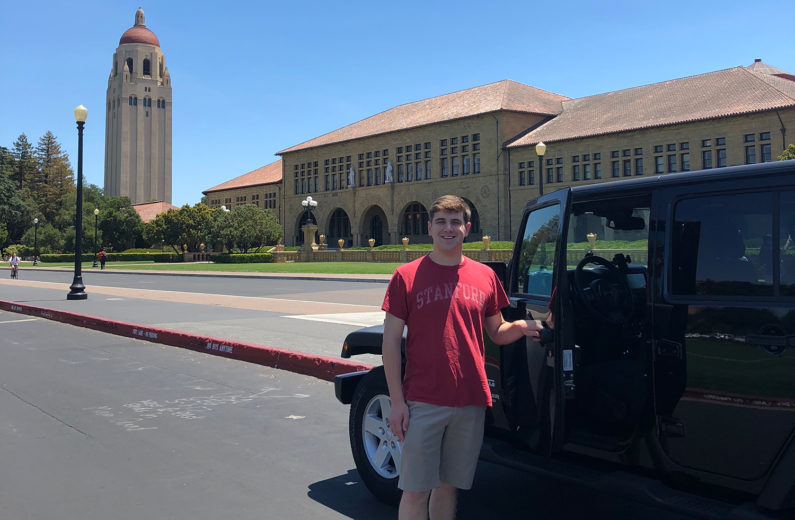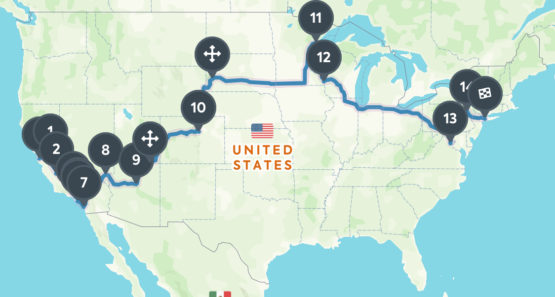Student politician goes cross-country
ASSU Senator Matthew Wigler, ’19, is taking a road trip this summer to America's swing districts to learn about the voters who reject partisanship in a time of great political polarization.
As the country becomes more divided politically, one group of Americans is bucking the partisan trend:
Swing voters.

Matthew Wigler, pictured on campus on July 3. He is traveling with Michael Gofman, executive director of the UC Davis College Republicans, for the first 16 days of the trip. (Courtesy of Matthew Wigler)
These citizens – who, in national elections, vote for one party’s candidate for president, and the opposing party’s candidate for Congress – are an anomaly to many political observers. But this summer, one Stanford student is road-tripping across America to visit the districts where these voters reside, to learn about their lives and hopefully return to campus with lessons that can help bridge the growing partisan divide.
“As the country grows more partisan, these are the voters who not only swing elections from one party to another, but also keep the parties pinned to some common point,” says Matthew Wigler, ’19, an ASSU senator and vice president of the Stanford Democrats. “Their future is the future of American politics.”
Wigler began his road trip and political research project at Stanford the day before Independence Day. He’ll travel coast-to-coast in a vehicle he borrowed from a family friend, ending the trip in late August in New York City. In the name of bipartisanship, he is traveling with Michael Gofman, executive director of the UC Davis College Republicans, for the first 16 days of the trip. Together they’ll visit gathering spaces like restaurants and coffee shops to interview swing voters and learn about their political views, their lives and concerns.
“I hope to investigate questions about both the issues that matter to them and the values that guide their approach to them,” Wigler says. “Fundamentally, I want to understand why they split their tickets between the parties in the past and whether we can expect them to continue doing so in the future.”

Wigler will visit several districts in California before traveling outside the state, eventually ending the trip in New York City.
In the 2016 election, swing voters in 35 congressional districts from 17 states split their ballots between Democrats and Republicans. Seven of those districts are in California, in places like Modesto, Bakersfield, Simi Valley, Irvine and Huntington Beach. The pair will visit all of them before Wigler continues on to a representative sample of districts outside California with his brother. Together, they’ll visit swing districts in Nevada, Colorado, Minnesota, Virginia and other states.
Wigler says the sample is meant to represent a balance between districts that voted for President Trump while sending a Democrat to Congress, and districts that voted for Hillary Clinton while voting for a GOP congressional candidate. The sample is also representative of urban, rural and suburban populations, as well as relatively homogenous and diverse districts. It includes this year’s most competitive districts in the midterm election and also represents each region of the country – the Southwest, Mountain West, Midwest, South and Northeast.
Wigler says the goal of his research is to understand how voters in these districts have withstood partisanship and keep their fingers on the pulse of both red and blue America at once by remaining open to both sides.
“Learning how the people of ‘purple’ America think, and how they entertain and act on both Democratic and Republican perspectives, may offer us a model by which we partisans might engage with one another as well,” Wigler says. “Ultimately, it’s the quest in search of common values that underlies the whole of this enterprise.”
“As young leaders, we have a responsibility at Stanford to model the type of discourse we want to see in our country,” says Wigler. “This summer I am determined to model that kind of dialogue and bring it back with me.”
During their road trip, Wigler and Gofman will write about politics on their blog, Swing District.
